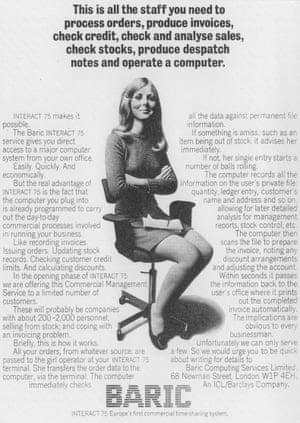
Sadie the typist and Susie her computer: sophisticated but cheap. That’s how the duo are billed when they appear in 1960s adverts to promote a now defunct UK computer company. Using young, attractive women to advertise computers was a common ploy in Britain at the time, when male managers, uninitiated in the complexities of this new technology, viewed the machines as intimidating and opaque.
“Computers were expensive and using women to advertise them gave the appearance to managers that jobs involving computers are easy and can be done with a cheap labour force,” explains technology historian Marie Hicks. They might have been on a typist’s salary, but women like Sadie were not typists – they were skilled computer programmers, minus the prestige or pay the modern equivalent might command.
As Hicks’ book Programmed Inequality illustrates, women were the largest trained technical workforce of the computing industry during the second world war and through to the mid-sixties.

They operated the huge room-sized electromechanical computers that cracked codes, worked out military logistics and made ballistic calculations during the second world war. Later they went on to work for civil service departments – operating the computers needed for government to gather data and run properly. “It was viewed as unskilled, highly feminised work,” explains Hicks. “Women were seen as an easy, tractable labour force for jobs that were critical and yet simultaneously devalued.”
Managers perceived women to be ideal for the computing industry because they didn’t think they needed to be offered any sort of career ladder, explains Hicks. “Instead the expectation was that a woman’s career would be kept short because of marriage and children – which meant a workforce that didn’t get frustrated or demand promotions and higher wages.”
But by the 1970s, there was a change in mindset and women were no longer welcome in the workplace: the government and industry had grown wise to just how powerful computers were and wanted to integrate their use at a management level. “But they weren’t going to put women workers – seen as low level drones – in charge of computers,” explains Hicks. Women were systematically phased out and replaced by men who were paid more and had better job titles.
Discrimination still remains
“Today, companies still perceive it as lucrative to treat women differently than men, to pay them less,” says Hicks. Facebook chief operating officer Sheryl Sandberg recently spoke out against the gender pay gap, prevalent in the tech space where giants like Google have been accused of systematically underpaying women. In May the company argued that it would be too much of a financial hassle to compile and hand over the salary records requested by the US Department of Labor. In August the Silicon Valley company was left facing legal action over the leak of a male software engineer’s 10-page manifesto criticising diversity initiatives and arguing that men occupy more leadership roles than women in tech due to “biological differences”.
“Even though companies like Google obviously weren’t around in that earlier period, they’re still benefiting from the same cultures that sidelined women,” says the author.

If women had continued to be a major force in computing, instead of being sidelined, the way the tech industry looks today would have been very different, she argues. “If women had been a more important part of the high tech industry all along, would so many platforms and apps have the same problems with rampant sexism and misogyny both in their workplaces and their products? Most likely not.”
The British computing industry lost its edge when it removed women – and ultimately, the move destroyed it, believes Hicks. “There were persistent labour shortages once women were thrown away – a lot of the young men who got trained to do these jobs soon decided to go and do something else because it was still seen as feminised work and there really wasn’t a career ladder at that point.”
The effect of sidelining women
If women had remained a part of the workforce, the scope and quality of computing products we have today – particularly software – would undoubtedly be better, says Hicks. She uses Dame Stephanie Shirley as an example of the sort of talent effectively written off by the mainstream industry at the time. In the face of repeated workplace discrimination, the 29-year-old went it alone in the 1960s and built up a thriving software business for female computer programmers.
In an interview with the Guardian earlier this year, Shirley said she knew her work at the Post Office’s prestigious Dollis Hill research station was good enough to get her promoted, but the promised promotion never materialised. “When I began to make it clear that I was pursuing a vigorous professional career, then it became a more entrenched position to keep me out,” she recalls. When the young computer programmer got married, it was expected that she would stop work immediately.
“Women continue to be weighed down with this sort of heteronormativecultural baggage,” says Hicks. “I think it’s clear that just relying on companies to do the right thing is not going to work and I think unions are going to have to become a major force again.”
[Source”indianexpress”]




